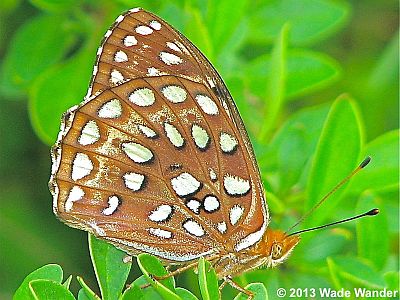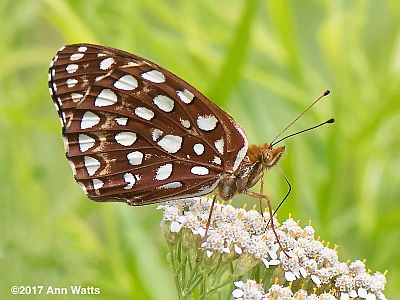New Jersey Butterfly Club
A chapter of the North American Butterfly Association (NABA)
Aphrodite Fritillary
Speyeria aphrodite
Identification: Medium—2.8” (smaller than Monarch). Very similar to Great-spangled Fritillary. Above: FW bright orange with a row of black spots, numerous irregular black bands, and a small, isolated black spot in inner area (Great Spangled lacks this spot). Below: FW bright orange and brown, with pale spots toward tip, and irregular black bands over a rosy flush at base; HW brownish-orange (male) to dark brown (female), with basal silvery spots and two bands of shiny, silvery spots separated by a narrow (almost nonexistent) cream-colored band. Because of the narrow pale band Aphrodite appears darker below than Great Spangled, which has a wide pale band.
NJ Status and Distribution: Resident? A northern and western species that is rare in NJ. Generally reported only during large outbreaks of Great Spangled Fritillary and even then only 1 or 2 are reported in a season by the most active observers. Since 2015 only a handful of reports, all from Sussex County. Formerly more widespread but probably always most likely in the northwestern counties.

Habitat: Open, sunny, uplands and wetlands with abundant wildflowers such as milkweeds and Wild Bergamot.
Flight Period: One extended flight period from mid-June to early October (most reported in July and August). Extreme dates: 6/19—9/27.
Caterpillar Food Plants: Violets (Viola). Female lays eggs near, but not on, violets in late summer.
Overwintering Stage: First-instar caterpillar.
Good Locations: Fields in the Delaware Water Gap NRA and Flatbrook-Roy and Walpack WMAs.
Comments: Seeing an Aphrodite in NJ is tantamount to seeing a Red-headed Woodpecker—only better! Reason enough to celebrate by heading for the nearest ice cream parlor.

Saranac Lake, NY, 7/29/04.

Fort Indiantown Gap, PA, 6/12/14, on Butterfly Weed.

Male, Sussex Co., NJ, 7/11/08.

Female, Delaware Water Gap NRA, Sussex Co., NJ, 7/14/17, on Common Yarrow (Achillea millefolium).

Bog White (aka Lance-leaved) Violet (V. lanceolata), a caterpillar food plant for Aphrodite Fritillary.